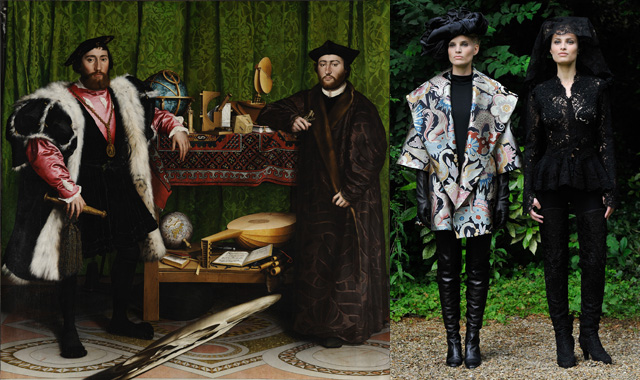Franck Sorbier and Modern Renaissance
As a child, Franck Sorbier was entranced by Joseph L. Mankiewicz’s 1963 drama Cleopatra, starring Elizabeth Taylor; he’s been gripped by a dual fascination with history and theatrics ever since. “I’ve always loved the epic films of the 1950s and ’60s like The Ten Commandments—they were grand spectacles, and there was something a bit magical about them,” the French couturier recalls. “And of course the costumes were so grand.”
For his 2013 fall/winter collection, Sorbier delved into the Middle Ages and early Renaissance. The erudite designer, who often references art and history in his work, found inspiration in the foliage decorating the margins of 15th- and 16th-century illuminated manuscripts, as well as in pieces by Flemish painters Jan van Eyck and Petrus Christus and Germans Hans Holbein the Younger and Albrecht Dürer. Sorbier said he was struck by the portraits executed by the masters of the period for the timeless “peace, fervor, and nobility” that stands out in them. All of his ensembles were named for famous painters, including the Limbourg brothers who created one of the best-known medieval illuminated manuscripts, Les Très Riches Heures du duc de Berry.
To obtain the intricate fabrics that set the tone for the show, Sorbier reached out to Tassinari & Chatel, a French silk-weaving factory established in 1680, as well as French upholstery firm Lelièvre, Italian silk maker Clerici Tessuto, and Venetian textile company Rubelli.
Using his signature compression technique—a nod to French artist César and his compressed metal sculptures—Sorbier created layers of lace that he then transformed into gowns with long trains, and doublets worn over black silk thigh-high boots. Of special note was a leather jacket with an elaborate pattern of woven leather cords.
“The idea was to create something modern but at the same time very historical, to remember those dresses that would make you dream when you were a child,” Sorbier explains. “I had this desire to return to something very beautiful, a bit like what I did with the Peau d’Ane collection,”he says, referring to his fall/winter 2012 show. Though inspired by the 17th-century fairy tale by Charles Perrault, the presentation was resolutely futuristic: partnering with software maker Intel, the couturier used 3-D video mapping to project whimsical images onto a white ball gown.
Over the years, Sorbier has paid homage to numerous artists, including 20th-century masters Jean Cocteau, Pablo Picasso, Jackson Pollock, Joan Miró, and Zao Wou-Ki. His spring/summer 2013 collection was inspired by American art patron Peggy Guggenheim. But his favorite painter remains Marc Chagall for his magical, “almost biblical” universe. The program for the fall/winter 2013 show includeda Chagall quote that Sorbier holds dear to his own practice: “If I create from the heart, nearly everything works.”
For Sorbier, fashion, as art, should be a reflection of the society in which it is produced. “If couture is not about culture today then it doesn’t really have a reason to exist,” he says. “Couture is here to defend a patrimony, one of the last refuges where you can let your imagination go wild, because otherwise everything is marketed for consuming. Even art can fall into that.”
As first published in BlouinLifestyle.com Oct edition







